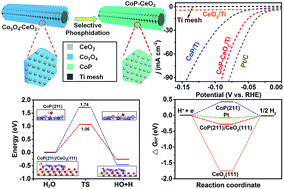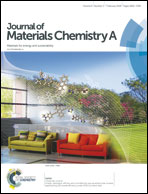Selective phosphidation: an effective strategy toward CoP/CeO2 interface engineering for superior alkaline hydrogen evolution electrocatalysis†
Abstract
Co phosphides, although highly active for the hydrogen evolution electrocatalysis in acids, still deliver inferior performance in alkalis, limiting their application in alkaline water electrolysis. Building an effective Co phosphide/(hydroxide)oxide interface could be a viable way to improve the hydrogen evolution activity of Co phosphide catalysts under alkaline conditions, which however remains unexplored and challenging. In this communication, we report the facile development of a CoP–CeO2 hybrid nanosheet film on Ti mesh (CoP–CeO2/Ti) from easily made Co3O4–CeO2via a selective phosphidation strategy. In 1.0 M KOH, such CoP–CeO2/Ti achieves a geometrical catalytic current density of 10 mA cm−2 at a pretty low overpotential of 43 mV, 27 mV less than that for CoP/Ti. Remarkably, our CoP–CeO2/Ti also shows superior durability over CoP/Ti, suggesting that CeO2 greatly stabilizes the CoP catalyst. Density functional theory calculations demonstrate that CoP–CeO2 possesses a lower water dissociation free energy and a more optimal hydrogen adsorption free energy than CoP. This selective phosphidation strategy is universal in engineering the transition metal phosphide/oxide interface for applications.



 Please wait while we load your content...
Please wait while we load your content...